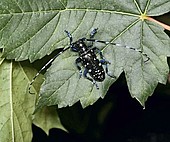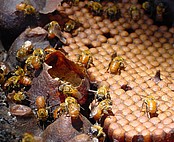Current Research Projects
Understanding the gentic basis of adaptive phenotypic differentiation among species is of broad interest in evolutionary biology.
Therefore, an important and challenging task is to understand how and why new traits arise that contribute to differentiation between species, and to identify the genes controlling these traits. While the amount of differentiation between species is often apparent, the cirtical steps that ultimately result in differentation occur at the population and subspecies level.
Hence, it is necessary to study the underlying evolutionary forces acting on genomes of populations, such as mutation, selection and random genetic drift. We are working on the identifications of candidate genes using different approaches.
Population dynamics and molecular evolution of sex-determining alleles
Honey bees and bumble bees are among the most important pollinators worldwide. The fitness of their colonies can be directly influenced by the nucleotide variation present in the populations, such as the number of different sex alleles and thus the proportion of diploid males. A reduction in the number of bees and bumblebees also results in a reduction in the biodiversity of wild plants due to insufficient pollination of entomorphic plants. Thus, it is of particular importance for us to understand the population dynamics of the sexual alleles of bees and bumblebees. The identification and characterization of the most important key regulators in selected species are part of our ongoing projects.
Exploring genomic signatures of modern apiculture in the Western honey bee
The objective of this project is to analyse paried samples of wild an managed honey bee populations to gain insights into potential signatures of demestication in the honey bee genomes. Further information
Morphologisch-molekulare Identifikation von Käfern an Verpackungsholz in der Pflanzengesundheit (Kooperationsprojekt mit LTZ Augustenberg)
In diesem Projekt werden neue Diagnoseverfahren für potentiell invasive Käferarten entwickelt, die im Rahmen der Kontrollen der Pflanzengesundheit auftreten können. Die Methoden umfassen klassische morphologische Bestimmungsschlüssel für eine mikroskopische Analyse von Käfern und ihren Larven, sowie molekulare Methoden (PCR). Ergänzt werden die Verfahren um Methoden zur molekularen Analyse von Populationen von Arten. Mit diesen Verfahren ist es möglich, Käferfunde von verschiedenen Befallsorten verwandtschaftlich miteinander zu vergleichen und wahrscheinliche Einschleppungswege von invasiven Arten nachzuvollziehen, z.B. des Asiatischen Laubholzbockkäfers (Anoplophora glabripennis). Mit diesem Forschungsprojekt sollen Gefahren für die Pflanzengesundheit in Deutschland abgewehrt werden.
Molecular insights into the early larval discrimination in Apis mellifera
The molecular basis of sex determination is well understood in the western honey bee Apis mellifera, in which the complementary sex determinant (csd) gene acts as the primary signal for sex determination of a downstream gene regulatory cascade based on allelic endowment. Homozygous csd individuals develop into diploid drones and have zero fitness, as they are recognized and removed by worker bees shortly after hatching. The signal that triggers this behavior is not yet known, but it has been proposed that cuticular hydrocarbons (CHC) play an important role in the differentiation of these diploid drone larvae. The objective of this project is to analyze paired samples of wild and managed honey bee populations to gain insights into potential signatures of domestication in honey bee genomes.
Honeybees are the most important pollinators of the cultural landscape but their health is affected by many environmental factors. Within the last years, microbial intestinal biocoenosis (intestinal microbiota) became more important to obtain a healthy and resistant immune system. The research of the environmental components (pesticide, feeding quality, aso) interacting with the microorganism causing a debilitating effect on the immune system and the health of the bees is at the very beginning.
Using modern technology, we analyze the structure and dynamic of intestinal microbiota of bees and the effect on the immune system to give contribution for sustainable bee keeping (cooperation with Apicultural State Institute Hohenheim, Peter Rosenkranz).
Finished Research Projects
The evolution of eusociality belongs to a major transition in evolution. Several newly sequenced genomes and transcriptoms of bees species differing in social complexity provide the basis for comparative evolutionary studies. This work is part of a cooperative effort together with international colleagues, leaded by Karen Kapheim and Gene Robinson.
Selection of Varroa-tolerant honey bees (SETBie)
The varroa mite (Varroa destructor) belongs to the major threat of colonies of the western honey bee (Apis mellifera) worldwide. A sustainable approach to control the mite population in a honey bee colony is by breeding varroatolerant honey bees. In the SETBie project beekeepers, beekeeper associations and various university institutions are working together to breed and establish a varroa tolerant honey bees in Baden-Württemberg via the behavioural trait Varroa Sensitive Hygiene (VSH). Bee colonies with this trait specifically remove varroa infested brood cells and thus reduce the mite density within a colony.
The project SETBie investigates the breeding trait VSH from genetic, methodological and beekeeping aspects.
Stingless bees: genome and microbiome
As part of cooperation with the Brazilian Universidad Federal de Amazonas, Manaus, coordinated by Carlos Gustavo Nunez Silva and funded by CAPES, we are sequencing and analyzing the genome of the stingless bee Melipona compressipes. This species, among other stingless bees, is wide spread distributed in the brazilian rain forest areas and has high economic importance.
Mitrochondrial haplotypes and phenotypes in laying hens
Mitochondria are involved in several organismic key processes; hence the in-depth characterization of mtDNA haplotypes and mt gene expression in hens with efficient P utilization and myo-inositol metabolism is of utmost importance. Myo-inositol is known to modulate mitochondrial functionality by so far unknown mechanisms related to autophagy and mitophagy.
In the proposed project we will obtain whole mitochondrial genome haplotypes for two distinct strains of laying. This approach determines potential mutations that arose during the genetic selection process in laying hens affecting key enzyme activities. To test for mt gene expression differences among distinct haplotypes, tissue and developmental-specific quantitative (q) PCR experiments will be performed. We combine our data with those of genome analyses obtained in other projects of the Research Unit to find associations of interacting loci depending on the nuclear background.
Thus, we will gain comprehensive insights into the functional importance of mitochondria in respect to Putilization and myo-inositol metabolism in hens.
DFG Forschergruppe P-FOWL (FOR 2601)




